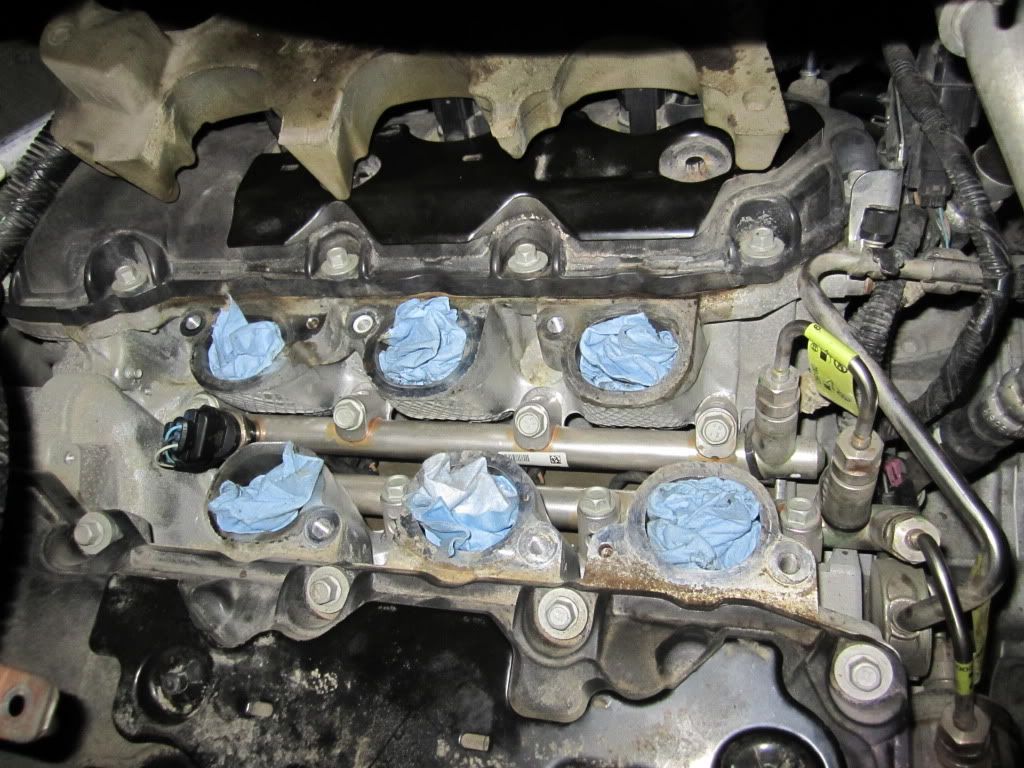XRDreamliner said:
Techron won't help on the DI engines for controlling intake deposits, since the fuel does not wet the back of the valves. All DI engine designs suffer from this issue, some worse than others. Here's a pic of buildup from the Audi 4.2L V8:
http://forums.quattroworld.com/rs4b7/msgs/58973.phtml
there is a partial truth.
Its true that the intake valves dont get soaked with fuel.
But stuff I had read in the past- hinted at GM's DI's getting a little fuel on the intake valves... (and thus my running Techron every 10K- to help every little bit on my Traverse)
Then recently saw this-- backing up what I had believed or a while....
GM recommends running their GM fuel system treatment PLUS.... (which is Techron Concentrate PLUS)..
Also used during a service procedure...
Im pondering going from every 10K to every oil change....
2011 Cadillac CTS | CTS VIN D Service Manual | Document ID: 2863222
#PIP5029: Engine Misfires Due To Major Carbon Deposits On The Intake And/Or Exhaust Valves - (May 29, 2012)
Subject: Engine Misfires Due To Major Carbon Deposits On The Intake And/Or Exhaust Valves
Models: 2008 - 2012 Cadillac CTS, STS
2008 - 2010 Chevrolet Cobalt SS, HHR SS
2007 - 2010 Pontiac Solstice GXP
2007 - 2010 Saturn Sky Redline
2009 - 2012 Buick Enclave
2009 - 2012 Buick Lacrosse
2009 - 2012 Chevrolet Traverse
2009 - 2012 GMC Acadia
2009 Saturn Outlook
2010 - 2012 Cadillac SRX
2010 - 2012 Chevrolet Camaro, Equinox
2010 - 2012 GMC Terrain
With any of the Following Direct Injected Gasoline Engines:
2.0 (RPO LNF)
2.4L (RPO LAF, LEA, or LUK)
2.8L (RPO LAU)
3.0L (RPO LF1)
3.6L (RPO LFX or LLT)
The following diagnosis might be helpful if the vehicle exhibits the symptom(s) described in this PI.
Condition/Concern:
Some customers may complain of a MIL and engine misfire. In some cases, the misfire may be more apparent on a cold start, may count on a single cylinder or several cylinders, and may or may not be felt by the driver. Upon inspection, the technician will find one or more misfire codes (DTC P0300-P0306) stored in the ECM and SI diagnosis may or may not isolate the cause of the misfire depending on whether the intake/exhaust valves are sticking at the time of the diagnosis.
This may be the result of major carbon build up on the intake and/or exhaust valves as shown below so the misfires should not have appeared until the engine has accumulated around 5,000 miles or more.
.
Recommendation/Instructions:
If this concern is encountered, perform SI diagnosis. If SI diagnosis isolates a valve sealing concern and/or eliminates everything else external to the engine, decarbon the engine with Upper Engine and Fuel Injector Cleaner by following the guidelines below:
Important Extreme care must be taken not to hydrolock the engine when inducing the cleaner, especially if it is induced without Kent Moore Tool # J-35800-A. If too much cleaner is induced at too low of a RPM, or if you force the engine to stall by inducing too much cleaner at once, the engine may hydrolock and bend a connecting rod(s).
1. In a well-ventilated area with the engine at operating temperature, slowly/carefully induce a bottle of GM Upper Engine and Fuel Injection Cleaner into the engine with RPM off of idle enough to prevent it from stalling (typically around 2,000 RPM or so). Depending on the engine configuration, induce the cleaner through the throttle body or an engine vacuum hose/pipe. For best results, it is suggested to induce the cleaner with Kent Moore Tool # J-35800-A (shown below).
2. Turn the engine off after inducing the cleaner and allow the cleaner to soak with the engine off for 2.5 to 3 hours (Do not let cleaner soak for more than 3 hours as remaining deposits may start to harden back up again).
3. Add a bottle of GM Fuel System Treatment Plus to the fuel tank and fill the vehicle with one of the Top Tier gasolines listed at
http://www.toptiergas.com and/or in the latest version of 04-06-04-047 (USA) or 05-06-04-022 (Canada). See Bulletin 05-00-89-078 for more details on GM Fuel System Treatment Plus.
4. Test drive the vehicle extensively to circulate the GM Fuel System Treatment Plus, which will help to eliminate/reduce any remaining intake valve deposits.
5. Re-evaluate the concern to determine if it is repaired or improved at all. If the concern is improved but not repaired, it may be necessary to perform the above decarboning process a 2nd time.
6. To complete the repairs, advise the customer to only use one of the Top Tier Gasolines listed at
http://www.toptiergas.com and/or in the latest version of 04-06-04-047 (USA) or 05-06-04-022 (Canada) to minimize future deposits. It can also be recommended to add a bottle of GM Fuel System Treatment Plus at every oil change as mentioned in the latest version of 04-06-04-051.
Kent Moore Tool # J-35800-A
Upper Engine and Fuel Injector Cleaner












